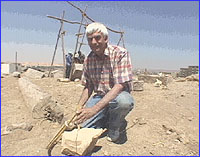
|
 |
 |
Set 5, posted March 16, 1999 previous set | next set Question: How did the ancient Egyptians drill stone before they had copper tools? Response from Denys Stocks, Ancient Egyptian Technologist: In my opinion, the evidence all suggests that the Egyptians were able to drill stone—not too-hard stone, certainly not granite—with hollow reed tubes and sand. Now, the sand would be dry, because if we use wet sand, that would make the stem of the drill collapse into a solid drill, which would be useless. They then took a bow, with an ordinary string maybe a couple of millimeters in diameter, and wound it round the shaft once, then put a capstone on, which had a hollow in it, so that it could rotate. Just apply a little bit of pressure, and gradually, the reed moved backwards and forwards by the bow bit into the stone. Question: What evidence from the ancient times suggests that obelisks were raised rather than built on the spot? What I am suggesting is that, why not build the obelisk piece by piece on the spot and raise it up gradually, and when it gets high enough, use pulleys attached to the tip of an A-frame to pull the small pieces to the top of the obelisk. The height of the A-frame could be adjusted to a required height each time a piece is pulled at the top of the obelisk. Response from Mark Lehner: All the Egyptian obelisks were single pieces of stone. They were not like the obelisk of the Washington Monument in Washington, D.C., which is composed of separate blocks of stone. Question: Being a New Yorker, I read with interest in 'A World of Obelisks' about the New York City obelisk. Do the Egyptians have a policy on having such artifacts returned? Response from Mark Lehner: No, because—I would have to check the records—but I think it was an official gift. And if something is an official gift, then there is no mandate for it to be returned. The issue of cultural property outside the countries of origin is a bit of a sensitive one and is often discussed. When objects and artifacts went out legally, then there's no question about it. It's when they go out illegally, or when artifacts end up in museums and collections abroad and have questionable origins that you get controversy—and rightly so. Question: Do you believe that pharaonic tombs still remain to be found in the Valley of the Kings or nearby? Response from Mark Lehner: Well, I think there might be tombs left in the Valley of the Kings. Some of my colleagues know that subject much better than I do, and they know the evidence for which kings they're missing. The great majority of the kings I believe are accounted for. But the tomb of Herihor is unknown, and he was high priest and virtual ruler of Egypt towards the end of the 20th dynasty. There might be a few other tombs missing, perhaps minor tombs from the Amarna period. It would be hard for me to conclude that everything is known and all the tombs are accounted for that were originally made in that valley. But, like I say, others who are actually working in the valley like Kent Weeks and others know these questions much better than I do and obviously they're out there digging, so there is still information, if not tombs to be uncovered. Question: What is the meaning of the obelisks? Response from Mark Lehner: The meaning of the obelisks has to do with solar worship. They definitely are inspired by Heliopolis, the ancient cult center northeast of modern Cairo, which was the seat of sun-worship, or the worship of the sun god Re. Explore Ancient Egypt | Raising the Obelisk | Meet the Team Dispatches | Pyramids | E-Mail | Resources Classroom Resources | Site Map | Mysteries of the Nile Home Editor's Picks | Previous Sites | Join Us/E-mail | TV/Web Schedule About NOVA | Teachers | Site Map | Shop | Jobs | Search | To print PBS Online | NOVA Online | WGBH © | Updated November 2000 |
 Video clip—Denys Stocks demonstrates his answer
to Richard's question:
Video clip—Denys Stocks demonstrates his answer
to Richard's question: